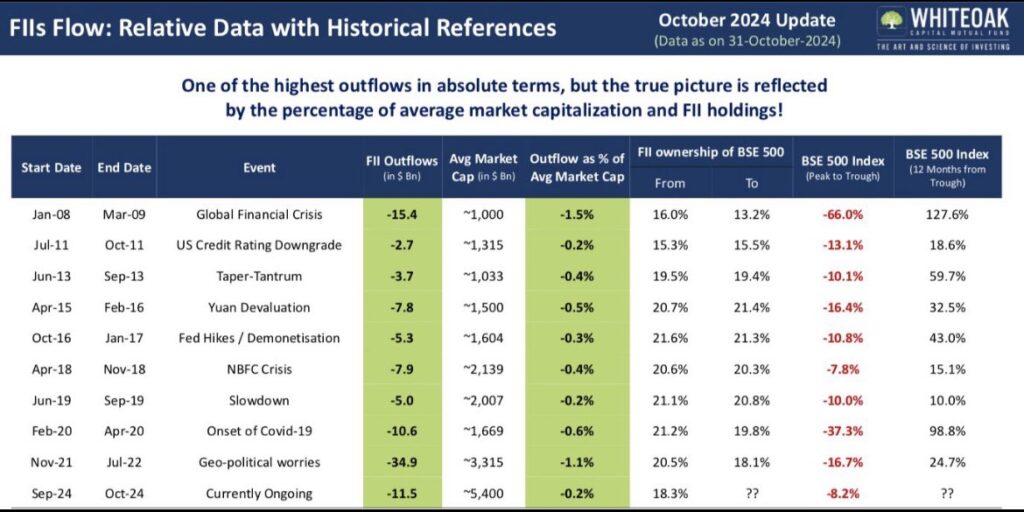FII Outflows and Market Cycles
In financial markets, outflows of Foreign Institutional Investors (FIIs) are a common event. These outflows often impact the market, but they are usually part of a repeating cycle. Looking at the history of FII outflows, there have been significant drops during major crises, like the 2008 Global Financial Crisis (GFC), where we saw $15 billion outflows, which was 1.5% of the average market capitalization. In comparison, recent outflows, such as the $11.5 billion we’ve lost now, are only 0.2%, showing that this is far from being a major event.

Historical Outflows and Their Impact
When we look back at November 2021 to July 2022, outflows were much larger, totaling $35 billion, or 1.1% of the market cap. However, nothing comes close to the 1.5% outflow during the GFC in terms of market cap percentage. The current 0.2% is similar to several past periods where outflows happened without creating long-term damage to the markets. These include instances like October 2011, where 3% was lost, and 2017 during the Fed rate hikes.
Cyclic Nature of FII Flows
FII flows tend to follow a cyclical pattern. When there are inflows, the market sometimes overshoots, followed by outflows that cause a correction. This cycle has repeated many times. What we’re seeing now, with the 0.2% outflow, is not out of the ordinary. These fluctuations are simply part of how the market functions and are not indicative of any exceptional event.
Declining FII Ownership
Over the years, Foreign Institutional (FI) ownership of Indian markets has gone up and down. After reaching 21.6% in October 2016, FI ownership has been declining. Currently, we are approaching levels below 18%, which haven’t been seen in the last decade. However, this might mean that the cycle of FII selling could stop soon. The reason is that large institutions find it difficult to move in and out of the market quickly, especially when they are looking at India with a long-term perspective.
Staying Put Through Market Cycles
It is important to note that long-term funds often stay invested despite temporary overvaluation. Because the Indian market is not as liquid for large sums of money, it’s not easy for big investors to exit and then re-enter. As a result, they might maintain their ownership levels even during periods of selling, keeping their position stable for the long term.
Opportunities After Big Dips
History shows that after every significant dip in the market, strong performance usually follows. Whether the dip was 10%, 13%, or 37% (as seen during the COVID-19 crash), the market tends to rebound with great results within a year. This pattern indicates that instead of waiting or worrying too much about short-term moves, one should stick to their investment plan, continuing to invest regularly.
WeekendInvesting launches – PortfolioMomentum Report
Momentum Score: See what percentage of your portfolio is in high vs. low momentum stocks, giving you a snapshot of its performance and health.
Weightage Skew: Discover if certain stocks are dominating your portfolio, affecting its performance and risk balance.
Why it matters
Weak momentum stocks can limit your gains, while high momentum stocks improve capital allocation, enhancing your chances of superior performance.
Disclaimers and disclosures : https://tinyurl.com/2763eyaz
If you have any questions, please write to support@weekendinvesting.com










